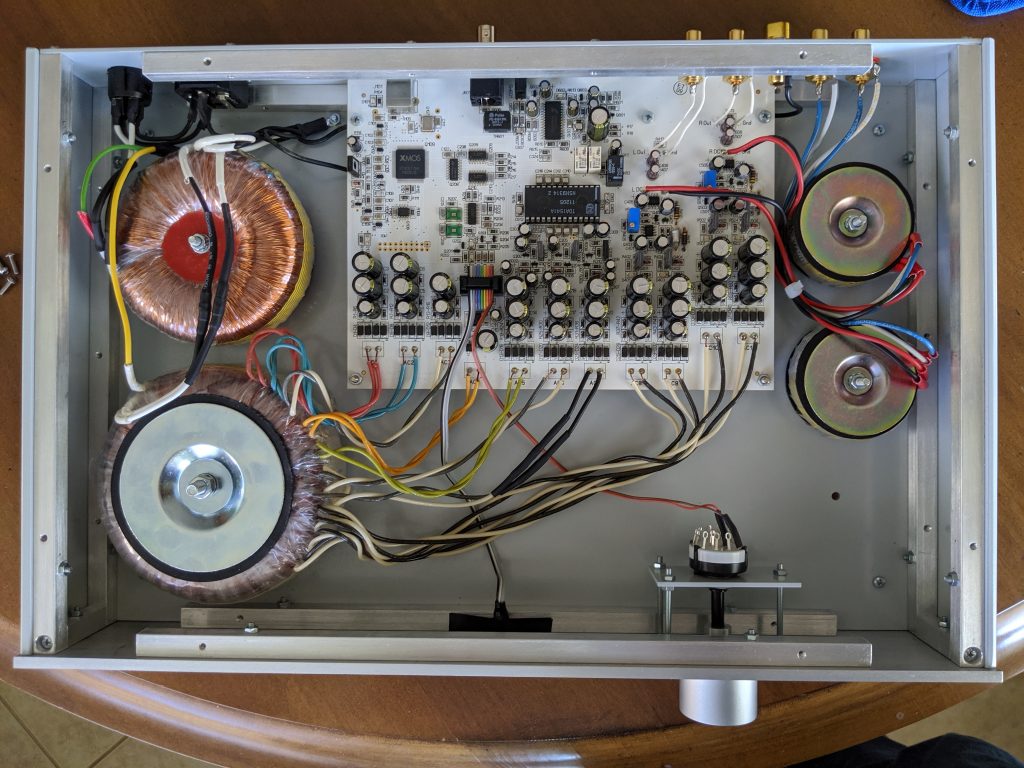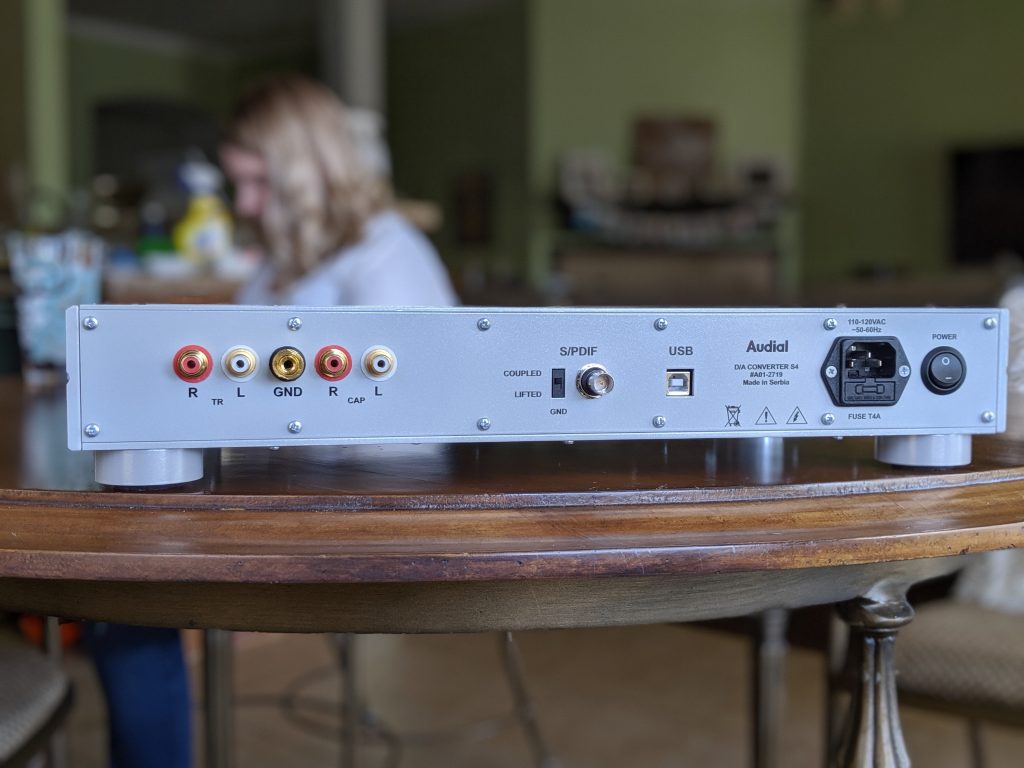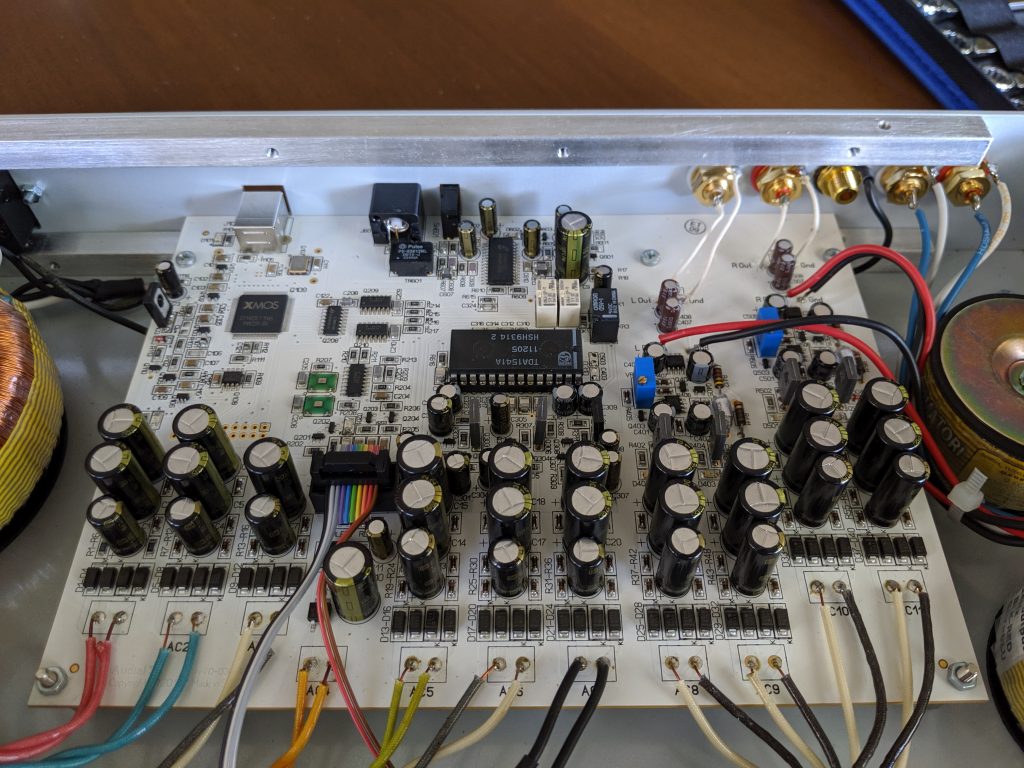The audio world is an interesting hobby to be in. In no other industry could subjective opinions weigh as much or more than objective. And yet, that’s where I often find myself. Sometimes, it’s almost infuriating.
D/A Converters are one of those hotly contested topics within audio. As I’ve pointed out in previous posts, I’m a firm believer in measurements when it comes to DAC’s. But at the same time, I’m also a firm believer in what my ears hear.
Does that mean my reviews could be considered scientifically flawed? Yes. I guess it’s fair to say that any review that brings personal opinion into the matter is flawed. But that’s okay.
Okay. Let’s get to the main course.
Introducing the TDA1541
The Philips TDA1541 can be considered by some to be the precursor to all modern D/A Converters. Introduced in the mid-late 80’s (with production ceasing around 1995), it was revolutionary to the market.
I won’t go into too much detail about the inner workings, because the fine fellows over at DutchAudioClassics already have a great article explaining things.
The major point to make though is that this is not a delta-sigma chip, like everything modern. Nope, it’s tried and true multi-bit. Like all chips back then, it was expensive to produce (at the time) and they ran hot. As such, it’s never been a recommendation to leave them powered 24/7 but instead save that for when you’re doing the actual listening
Old vs New
A question I often asked myself before I heard the Audial S4 for the first time was, “Why do I have any reason to believe that this will sound good if, at its core, is a chip that’s almost 25 years old? This question becomes paramount when we consider that you can buy a top performing dac these days for pennies on the dollar. So, why should I care about this old monolithic dac?
Well, that’s because it still measures great! While I would never consider myself an aficionado, I do know that 16-bit depth music is, for all intents and purposes, audibly indistinguishable from its 24-bit brethren. Even before I read about the science behind this, I already knew it to be true based on self conducted ABX listening. Even with a highly resolving system, I was unable to tell the difference between the same song at these two bit depths. Most of the time at least.
This, strangely enough, works out perfectly for the TDA1541A (and S4 by extension), since its maximum supported bit depth is… drum roll please…. 16 bits. And this is extra nice since the most common form of lossless music is “CD quality”, or 16 bits.

A word about specifications
I had some time to exchange emails with the mastermind behind the S4, Pedja, and I came away very impressed with his deep knowledge of the old chip and all of its quirks. If you read his blog posts here <insert link>, you’d see that he’s taken the chip to its very limits. Not only that, but he did the research to find which “batches” of chips were the best of the best. Yes, the dedication to his craft is most impressive.
Pedja takes pride in his measurements, but also takes care in bringing out the true “nature” of the 1541 sound signature. The quoted distortion numbers are 0.003% @ -6dBFS, reaching a still impressive .9% @ -60dBFS. If my math is correct, that gets you roughly 90.5 dB of SINAD. That is spot-on with the TDA1541 specifications, so clearly this is wringing out every drop of performance possible.
If we take a look at the output impedance, we see that it’s a wonderfully low 3.5 ohms. Optionally, you can opt for additional transformer coupled outputs that have a 30 ohm output impedance.
Now, this is my favorite part. At the time of ordering, you can specify if you want support for the 384 kHz sample rate. This is especially nice, because it allows the user to decide what’s more important. Better measurements (like jitter and such), or support for a higher bit-rate. Personally, I chose measurements and so stuck with 192 kHz being the max sample rate.

Delivery and Setup
Communication from Pedja as wonderful as he made sure to keep me notified of progress on my DAC. Shipping was roughly 4-5 days to the USA, and another day or two my doorstep. As you’d expect from any top-end product, it was packed extremely well – there was no chance of damage during shipping.
I set it up in my reference system, consisting of a Rega Osiris driving Rega RS10 loudspeakers. This system is truly capable of resolving different components before it, so it seemed the perfect companion to this top-tier DAC.
On the streaming side, I use Roon connected directly to the DAC via USB.
Sound
Before talking about the sound of a DAC, I feel the need to explain (more here) my internal conflict about DAC transparency versus my feelings on how it sounds. As an engineer, I fully acknowledge and believe in measurements. In fact, I regularly seek out measurements to enhance gear that I review. My main conflict, though, also comes from said measurements. They tell me that this S4 should be sufficiently “transparent”, or rather it shouldn’t make a single difference to the sound of the speakers. My experiences though tend to tell a different story. What do I believe? The measurements or my ears? While I believe this to be one of the best parts of being in the audio hobby, it’s definitely a point of contention for some.

Now back to the review.
My defacto album for starting on a new DAC is almost always “The Courage of Others” by Midlake. Their hometown is just down the street from me, so it’s fair to say I’ve known their sound for a long time. Their sophomore album not only has a little bit of everything, but it’s well recorded and mastered.
The S4 here did a splendid job from beginning to end. The magic of the TDA1541 was not lost, but instead brought out in its purest form. In particular, I found myself lost in the vocals, much more-so than any other DAC I’ve ever had in my system. Instrument separation was good, I had no problems closing my eyes and “pointing” to where the sounds were coming from. As sounds bounced between the two speakers, I was easily able to follow. As the going got tough with more dynamic and complex music, the S4 kept on going without showing a hint of having trouble.
Coming back to the vocals, I consistently see this as a strong point of the TDA1541. I’m not entirely sure what it is, but it imparts a wonderful bit of magic on the vocals. Its performance there is completely bewildering considering the measurements that would say otherwise.
If I had to be nit-picky about the performance, it would be entirely based on the bit-depth limitation. While I myself have a hard time consistently telling the difference between 16 and 24 bit, I know some people will be less than enthusiastic. I didn’t find it a shortcoming in my listening sessions, but instead found it re-assuring in regards to the long-term stability of 16-bit content.
In Conclusion
In short, the Audial S4 is TDA1541 perfection in a box. I have listened to my fair share of DAC’s using this chip, but this is by far the best. Pedja flexes his engineering muscles by delivering one of the best experiences I’ve ever had the pleasure of listening to.
For anyone that is hesitant about a DAC that’s a blast-from-the-past, especially when modern offerings with excellent measurements can be had for far less, fret not! This S4 is the real deal. It proves that a two decade old design can stand up to modern times and proves, yet again, that it’s not the chip, but the implementation that matters.
If you don’t mind parting ways with your wallet, you can find the absolutely splendid S4 here.


Hi,
Which other dac’s using this chip would be your second and third choices?
Thanks!
Hey Patrick,
I also have the MHDT Orchid which I quite enjoy. It’s not as detailed (nothing will be), but the vacuum tube output buffer does give it a nice euphoria that sounds great with solid state electronics in my opinion. It’s a nice option when you prefer solid state in the rest of your system.
I’ve had a few old philips gear and some other boutique manufacturers as well. To be honest, the only one I can recommend is Audial. Pedja (owner) really knows his stuff and I’d feel lucky to have any of his dacs in my system.
Patrick,
Thank you so much for the thorough review.
It is interesting to note that in the early days of CD players, Rotel manufactured a couple of models: the RCD-865 1-bit CD player (which I owned…and it sounded dreadful), and the lower-cost, RCD-855 Player, which used a multi-bit DAC Chip…the TDA1541A which is used in the Audial S4! I will quote from the hi-fi news and Record Review of July 2017 in which the RCD-855 is reviewed: “At its core, the TDA1541 series used a technique called Dynamic Element Matching (DEM), a method of deriving the vital scaled ladder of 16 current sources essential to the multibit conversion process from a single internal reference rather than from a difficult-to-produce chain of precision resistances. Since it is not possible to form capacitors of sufficient value on a silicon chip, seven external components per channel are required by the TDA 1541 to complete the DEM circuit. In budget players they would be tiny surface-mounted ceramic types, but these are low-accuracy components which are sensitive to temperature changes and mechanical vibration. By adopting film capacitors here, Rotel ensured the TDA1541A DAC could give its best performance under all conditions.”
Your review whetted my appetite for the S4! Would you have any idea of whether the unit is available in Israel? Otherwise, my alternatives would be the HEGEL HD2, one of the cheaper Schiit’s, The Brooklyin Mytek, or, for “personal” use, the excellent AudioQuest Dragonfly Cobalt ($300 at Amazon), which is equipped with an improved micro-processor, a higher-current headphone output, and MQA decoding to boot!
Thanks again for the great review!
Best Regards,
Yuval Goldstein.
I recognize that quote 🙂 I am in complete agreement that the sound of the TDA1541A is entirely dependent on the implementation of the surrounding circuit. If you look at Pedja’s blog, he has spent nearly two decades researching and discovering how to get the most out of the chip. He’s very results (both measured and heard) oriented, so I personally believe that if he actually thought newer delta-sigma designs were better he would have moved on a while ago.
As for if he’ll ship to you. While I no doubt he would no issues shipping to you… you should email him directly at [email protected]. He’s very good about responding.
Good luck!
Read with quite some interest this review as at one time for about a 2 year period i owned an Audial S2! I remember well the first time i placed it in my system, and thought to myself: Wow that sounds like real music!! (I had a delta sigma sabre based DAC at the time and loved its deep bass but after listening to the Audial i quickly sold the Sabre as it seemed to chop up the musical delivery of notes).
I wonder how the old olive Naim CD players would compare against Pedja’s dac’s. I currently have his Aya 4 and it is by far the best dac that I have heard. I’ll never go back to delta sigma either ( I have had different Sabre, Burr-Brown and AKM dac’s).
Hey Patrick,
That’s a great question. I’ve only heard from others about the old Naim components that used the same chip. They rarely come up on the used market and when they do, they command a premium for sure.
That said, I would not be surprised if Pedja’s components still performed to a higher degree since they are newer and utilize newer methods for extracting the most from the 20+ year old chip.
Hi Matthew,
I guess you’re right about those old Naim CD players. What surprises me is that you can get an old Rotel cd 855 for about 100$ with almost the same chipset as the Naim’s cd 1-2-3. Good luck if you find one of those below 1200$ though…
And yes, we are lucky to have Pedja’s products. Very lucky :-).
Have you rolled ECC86 tube in your Orchid using tube adapter. A few people tried it and said huge improvement over stock tube. I tried it as well and heard big improvement. Only wish it has darker background
Matthew, I also have the MHDT Orchid Dac and it’s certainly a great bargain and offers an alternative to sigma delta Dacs. My Question is this. The Audial S-4 is still a Chip Based Dac and Pedja is an artist but I’m wondering how you feel it competes against a fully formatted resistor Dac like the Denafrips – Metrum Psvane – or the Aqua Dacs. I appreciate your time and thank you in advance for your time. Cheers, Brett
I have an Orchid, Abbas Audio, and a Sparkler Audio S-512 NOS Dacs. I liked the Orchid, but in my tube rig I have a preference for the non-tubed Sparkler.
I read Matt’s review and have an S-5 on the way and will post after it arrives.
Hey Lester,
I understand and agree with that sentiment. The Orchid is probably best served in a full solid-state system, but even then I would argue the Audial S5 is better. It’s been in my reference system since I received it and I’ve never looked back. Makes me wish I had gotten the XLR outputs on my S4 years ago.
I’ve had the S5 for a couple of months and it is superb. Red Book CD has never sounded so good. I could care less about ‘hi-rez’.
Hey Lester,
I’ve been thinking about getting an Abbas 2.2 or 2.3. Would be extra nice to be able to pay to Ukraine now 😃 Which Abbas dac do you have? And do you think the Audial beats it?
Hey Halli,
Sorry for the rather late reply – real life things got the better of me this year. Kids and all 🙂
As I don’t have, nor have I heard the Abbas 2.2 or 2.3, it’s hard for me to say. As long as it’s multi-bit though, you’re probably in good shape. After all these years, it’s still hard for me to place my finger on it with regards to why I prefer multi-bit over delta-sigma. Just more pure I guess!
Cheers,
Matt